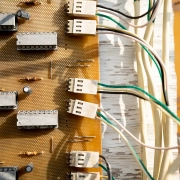The importance of placement studies in antenna design
When designing antennas for different devices, one of the critical steps is the placement studies. These studies involve simulating the antenna together with the device casing and its other internal components.
Proper placement studies are important for making sure an optimal performance and efficiency of the antenna.
Let’s take a closer look into these studies, what elements to include and exclude from simulations, the challenges faced, and strategies to overcome these challenges.
Why placement studies matter
- Real-world performance
Antennas rarely operate in isolation. They are integrated into devices surrounded by various materials and components that can significantly impact their performance. Simulating the antenna within its intended environment helps predict how it will behave in real-world conditions. - Interaction with surrounding materials
The materials used in device casings and internal components can reflect, absorb, or scatter electromagnetic waves, altering the antenna’s radiation pattern and efficiency. Placement studies help identify these interactions and allow for adjustments before physical prototypes are built. - Compliance with standards
Making sure that the antenna meets regulatory standards for radiation and efficiency is also important. Simulating the entire device helps ensure compliance with standards such as SAR (Specific Absorption Rate) limits, which measure the rate at which the body absorbs RF energy.
Elements to include in simulations
- Device casing
The casing material and shape can affect the antenna’s performance. Including the casing in simulations helps understand its impact on the radiation pattern and overall efficiency. - Internal components
Batteries, circuit boards, screens, and other internal components should be included as they can introduce electromagnetic interference (EMI) and affect the antenna’s performance. - Conductive materials
Any metal parts or conductive materials within the device should be included to understand their reflective and absorptive effects on the RF signals. - Proximity to user
Simulating the device in scenarios that mimic real-world usage, such as a smartphone held in hand or a smartwatch on a wrist, helps predict how human interaction affects performance.
Elements to exclude from simulations
- Non-relevant components
Components that do not interact significantly with RF signals, such as non-conductive screws or purely mechanical parts, can be excluded to simplify the simulation. - Detailed wiring
While essential wires should be included, overly detailed modeling of wiring can complicate the simulation without providing significant insights. Simplified models or representative elements can be used instead.
Challenges in placement studies
- Complex interactions
The interactions between the antenna and surrounding materials can be complex and difficult to predict. This requires detailed simulations and often iterative processes to achieve accurate results. - Computational load
Simulating an entire device with all its components can be computationally intensive. High-fidelity models demand significant processing power and time, which can be a limiting factor. - Dynamic environments
Devices are used in various environments, each affecting the antenna differently. Simulating multiple scenarios adds complexity but is necessary for a comprehensive understanding.
Strategies to overcome challenges
Start with simplified models to identify major issues and gradually add complexity. Using simulation software can help model complex interactions accurately and offer capabilities to handle large simulations efficiently.
Accurate material properties are important for reliable simulations. Conducting material characterization studies to obtain precise dielectric and conductive properties can improve simulation accuracy.
Using parallel computing resources can significantly reduce simulation times. Distributing the computational load across multiple processors allows for more complex simulations to be run efficiently.
What you should take from this?
Placement studies are a fundamental aspect of antenna design, providing insights into how an antenna will perform within its intended device and environment. By simulating the antenna and the casing with internal components, engineers can identify potential issues and optimize designs before physical prototypes are built.
Despite the challenges, using advanced simulation tools, accurate material characterization, and efficient computational strategies can help overcome these challenges, leading to better-performing and more reliable antennas in the final products.


